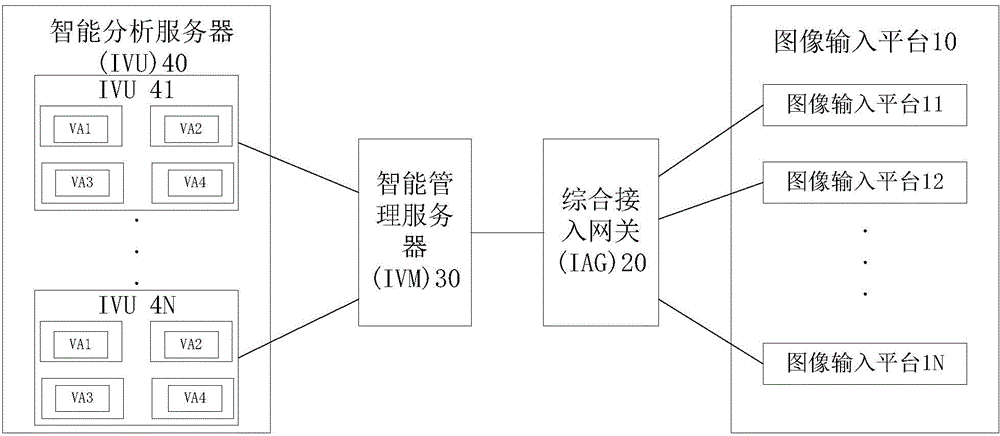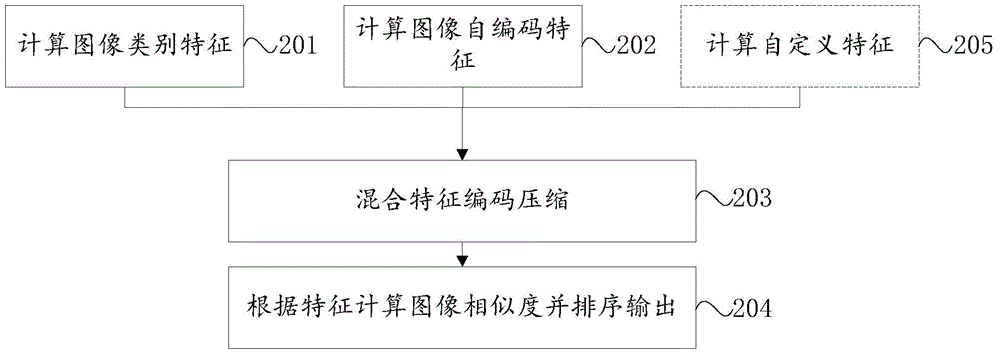Method and system for searching images by images based on deep learning
A deep learning and image technology, applied in the field of image search based on deep learning, can solve problems such as difficult control of high-level features, and achieve the effect of meeting the needs of fast analysis, fast search results, and reducing impact
- Summary
- Abstract
- Description
- Claims
- Application Information
AI Technical Summary
Problems solved by technology
Method used
Image
Examples
Embodiment 1
[0025] Embodiment 1 of the present invention provides a deep learning-based image search system, such as figure 1 As shown, it includes an image input platform 10, an integrated access gateway 20, an intelligent management server 30 and an intelligent analysis server 40, and the image input platform 10, the integrated access gateway 20, the intelligent management server 30 and the intelligent analysis server 40 are connected in sequence, specific:
[0026] The image input platform 10 is used for image entry, image transmission, image storage and image preprocessing; the integrated access gateway 20 is used for statistical access of the image input platform to the intelligent management server; the intelligent management The server 30 is used to manage and analyze resources; the intelligent analysis server 40 is a functional entity of image search, composed of multiple image analysis units, and each image analysis unit can independently complete the analysis of an image input p...
Embodiment 2
[0028] Embodiment 2 of the present invention provides a deep learning-based image search method, which is characterized in that it includes:
[0029] In step 201, image category features are calculated, and the trained deep convolutional neural network is used to extract classification features from the input image;
[0030] In step 202, the image self-encoding feature is calculated, and the encoded feature is extracted from the input image using the trained automatic encoding algorithm of deep learning;
[0031] In step 203, the mixed feature coding is compressed, the classification feature and the image self-encoding feature are integrated, and these features are encoded by a deep learning automatic encoding algorithm;
[0032] In step 204, the image similarity is calculated according to the features and the output is sorted.
[0033] This embodiment uses the deep convolutional neural network to generate high-level features to help analyze image categories and ensure that t...
Embodiment 3
[0047] Embodiment 3 of the present invention provides specific implementation methods for the implementation of Embodiment 1 and Embodiment 2 in combination with actual cases. It specifically includes five parts as described in Embodiment 2: calculating image category features, calculating image self-encoding features, calculating self-defined features, mixing feature encoding compression, and calculating image similarity and sorting output.
[0048] Part 1: Computing image category features
[0049] The algorithm for calculating image category features uses a deep convolutional neural network, such as the "ImageNet Classification with Deep Convolutional Neural Networks" algorithm described in the article. The network consists of 5 convolutional layers and 3 fully connected layers. The image passes through the convolutional layer and The fully connected layer finally obtains the method of high-level image features, which are mainly used for image classification.
[0050] The ...
PUM
 Login to View More
Login to View More Abstract
Description
Claims
Application Information
 Login to View More
Login to View More - R&D
- Intellectual Property
- Life Sciences
- Materials
- Tech Scout
- Unparalleled Data Quality
- Higher Quality Content
- 60% Fewer Hallucinations
Browse by: Latest US Patents, China's latest patents, Technical Efficacy Thesaurus, Application Domain, Technology Topic, Popular Technical Reports.
© 2025 PatSnap. All rights reserved.Legal|Privacy policy|Modern Slavery Act Transparency Statement|Sitemap|About US| Contact US: help@patsnap.com


